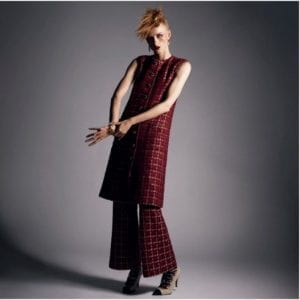This online blog post features materials protected by the Fair Use guidelines of Section 107 of the US Copyright Act. All rights reserved to the copyright owners.
Blog post by Tanvi Athavale
Introduction
As one of the most well-known and well-respected fashion houses, Chanel has created several iconic styles that have stood the test of time. The Chanel suit is a style that has been recreated and redesigned over the years but has remained a symbol of the brand. Designed originally by Coco Chanel in 1925, the first Chanel suit had a boxy wool tweed silhouette with a braided trim that allowed women to be comfortable while going about their day. This looser silhouette was in contrast to the earlier popularity of corsets and contributed to the push towards more functional clothing for women.[1]As Coco Chanel said, she wanted to dress women in “suits that make them feel at ease but that still emphasize femininity.”[2]
This Chanel black wool “motorcycle” suit from the Cornell Fashion + Textile Collection (Accession Number 2002.05.076ab) (see Figure 1) was created in 1995, and was worn by Dorothy Schefer Faux ‘69, former senior editor of Vogue.[3] It is one of many examples of a twist on the original Chanel suit. This suit features gold basket buttons and gold zippers on the front, which create contrast in color, value, and texture from the otherwise monochromatic black fabric. The metallic details also diverge from the warm-looking material of the rest of the suit, creating an interesting juxtaposition. The buttons are a form of point that draw the eye immediately to the center of the jacket. The asymmetrical, vertical zipper detail on the front of the jacket is a form of line which elongates the body visually. On the skirt, the zipper pulls hang at the center of the body, which in combination with the zipper placement, draw the eye inward and slims the waist. The proportions of the suit are meant to flatter the wearer, as the jacket hits at the hips and elongates the torso. The slim fitting knee length skirt also creates a sleek form on the wearer’s bottom half. The form of the suit feels structured because of the emphasized shoulders and large lapels.
It’s easy to imagine the wearer of this suit – a working woman in New York City, perhaps grabbing a coffee on her way to the office. She likely feels comfortable, confident, and chic, as the Chanel woman values comfort and ease. The wearer of such a suit in the 1920s would have a similar experience – she would feel much freer than if she were constrained by a corset and would be able to take on more of an active lifestyle.
Materials
The wool material of the suit is considered “classic” since the original Chanel suit was also wool. The weave structure is plain. The overall non-tailored silhouette also mimics the original design from 1925. However, the gold details of the suit indicate that this suit is a later version than the classic, as these details only started being incorporated into the designs after 1954.[4] As seen from Figure 2, this wool suit was made in France. Originally, Coco Chanel used Scottish factories for production of her suiting fabric, but soon after switched their locations to France. Around this same time, the fabric of the suits evolved to wool blends with silk linings, as can be seen from this particular suit. The two pieces of the suit, although cut from different patterns and requiring different production methods, must have been produced at the same facility and at the same time, since they use the same raw materials. As is common for Chanel’s techniques, this suit probably used a mixture of dressmaking and tailoring techniques.[5]
The Chanel Suit Over Time
On the suit jacket in Figure 3 the boning creates structure. This contrasts from the original Chanel suit which had a softer, even less tailored structure, as can be seen from Figure 4. As silhouette trends change over the years, the variations, cuts, and structures of the suits mimic those trends. For example, in Chanel’s Fall/Winter 2020-21 Haute Couture collection, the suit returned to the runway with long, flared pants with a long sleeveless waistcoat in a tweed material, as seen in Figure 5. This reimagined suit is very different in aesthetic and style from the original suit or even the 1995 wool suit. What remains consistent is the tweed material and overall non-structured fit which can be seen as a common thread between most Chanel suits.
In the mid to late 1900s, Chanel suits took on even more decoration, including braiding on the trim, jeweled buttons, and chain technology on the inside to make sure that the jackets sat right on the woman’s body.2 After Coco Chanel’s death when Karl Lagerfeld (1933-2019) took over creative direction of the house in 1983, he took the reimagination of the Chanel suit to the next level. Lagerfeld especially experimented with proportion and volume to create more modern silhouettes for each season. Virginie Viard, current creative director at Chanel, continues to reimagine the suit and bring more modernity to it.

Figure 4. Coco Chanel wearing one of her suits, 1931. https://journals-sagepub-com.proxy.library.cornell.edu/doi/pdf/10.1177/0887302×07305572
The Chanel suit is so iconic that it is often recreated, replicated, and copied by others. For example, Tracy Jennings of Dominican University created a tweed suit inspired by the iconic Chanel suit to showcase how much Chanel and its famous designs have historically influenced fashion. In Jennings’ suit, she used a wool-rayon blend material and several classic Chanel techniques, including intentional seaming, gold buttons, and a U-shaped neckline. In Summer 2005, the Metropolitan Museum of Art held a showcase exhibition on Chanel’s innovative and iconic styles, including the suit, and the way these garments changed the lifestyle of women in the 1900s. Chanel’s borrowing of details from menswear, prioritization of functionality in material choices, and unusual textural elements are common threads in the iconic suit. These are all elements that can be seen in the 1995 suit – the funky button decorations, wool material, and functional fit of the garment are classic Chanel choices.

Figure 5. Chanel Fall/Winter 2020-21 Haute Couture suit. https://www.chanel.com/us/haute-couture/fall-winter-2021-22/
Today, the Chanel suit and its inspired recreations are also worn by more diverse wearers. Now, consumers can find Chanel imitations at Zara or H&M, which shows how visionary the suit really is. In July 2021, as seen in Figure 6, Olivia Rodrigo wore a vintage pink and black Chanel suit to the White House and sparked an increase in popularity of the suits in Gen Z audiences.[6] Celebrities have been wearing Chanel suits for nearly a century now, which emphasizes the prestige, luxury, and overall yearn for the iconic style.
The Chanel suit will arguably never go out of style and will continue to be an iconic symbol of luxury, fashion, and status. From Coco Chanel’s original suit in 1925 to the countless variations still to come, the timelessness of the Chanel suit is unmatched.

Figure 6. Olivia Rodrigo wearing a vintage Chanel suit.
https://www.vogue.com/article/olivia-rodrigo-white-house-chanel-suit
[1] https://www.vogue.com/article/how-karl-lagerfeld-redesigns-the-iconic-chanel-suit
[2] https://www.marieclaire.com/fashion/a32391731/chanel-jacket-history/
[3] https://cornellfashion.pastperfectonline.com/webobject/173D3AF1-1708-4333-9AD0-573899299370
[4] https://www.metmuseum.org/art/collection/search/83591
[5] https://journals-sagepub-com.proxy.library.cornell.edu/doi/pdf/10.1177/0887302×07305572
[6] https://go-gale-com.proxy.library.cornell.edu/ps/i.do?p=AONE&u=nysl_sc_cornl&id=GALE%7CA669658085&v=2.1&it=r&sid=ebsco
Works Cited
Allaire, Christian. “Olivia Rodrigo Heads to the White House in a Vintage Chanel Suit.” Vogue, Vogue, 14 July 2021, https://www.vogue.com/article/olivia-rodrigo-white-house-chanel-suit.
“Chanel suit finds new fans in Gen Z channelling 90s nostalgia; Young fans drawn to preppy suit worn by Olivia Rodrigo at White House and cast of Gossip Girl reboot.” Guardian [London, England], 26 July 2021, p. NA. Gale Academic OneFile, link.gale.com/apps/doc/A669658085/AONE?u=nysl_sc_cornl&sid=ebsco&xid=3ae7d471. Accessed 6 Dec. 2021.
“Cornell Fashion + Textile Collection.” 2002.05.076ab – Motorcycle Suit, Black Wool, https://cornellfashion.pastperfectonline.com/webobject/173D3AF1-1708-4333-9AD0-573899299370.
Errico, Joseph. “Know Your History: The Chanel Jacket.” Marie Claire Magazine, Marie Claire (US), 28 May 2020, https://www.marieclaire.com/fashion/a32391731/chanel-jacket-history/.
Jennings, Tracy. “Shades of Chanel.” Clothing and Textiles Research Journal, vol. 26, no. 1, 2008, pp. 91–93., https://doi.org/10.1177/0887302×07305572.
Metmuseum.org, https://www.metmuseum.org/art/collection/search/83591.
Yotka, Steff. “Karl Lagerfeld’s Most Memorable Twists on the Iconic Chanel Suit.” Vogue, Vogue, 7 Mar. 2016, https://www.vogue.com/article/how-karl-lagerfeld-redesigns-the-iconic-chanel-suit.



